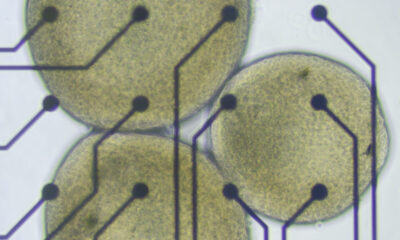Technology
Wi-Fi Connectivity Issues Disrupt Learning at Antioch High School

Students and teachers at Dozier-Libbey Medical High School in Antioch, California, are experiencing significant disruptions to their learning due to ongoing Wi-Fi connectivity issues. As schools increasingly rely on digital resources for education, consistent internet access has become essential for effective learning.
Many students at Dozier-Libbey utilize online educational platforms such as IXL and the College Board for their coursework. However, a number of students report that the school’s unreliable Wi-Fi frequently interrupts their ability to complete assignments and participate in online assessments. “Dozier-Libbey never had the best Wi-Fi, but I’ve noticed this year’s was worse,” said Ahmad Ali, an 11th-grader. “It seems like the entire school is on the guest Wi-Fi, so whenever everyone is connecting to the school’s internet, you have the majority of students on one connection.”
To better understand the scope of the issue, Gianni Callwood, an 11th-grade student and the new student representative on the Antioch Unified School District (AUSD) board, conducted a survey. The results confirmed that Wi-Fi problems were a primary concern among students, with all 21 respondents mentioning issues such as “extremely poor internet” and requests to “please fix the Wi-Fi.”
The impact of these connectivity issues extends beyond mere inconvenience. Students like Daniela Edeh, a 12th-grader, express frustration, stating, “I feel like the internet is such a big barrier when it comes to my education at times because it keeps me from doing the work I need to get done on time.” Fellow student Oluchi Chimara, a 10th-grader, emphasized the stakes involved during timed assessments. “Sometimes when you open the tests, the Wi-Fi will stop working, but the time keeps running. It gives you less time to answer the test questions, so if you’re rushing through questions, it can harm your score.”
Teachers also face challenges due to the unreliable internet connection. Calida Martinez, a biology instructor, shared her workaround: “Oftentimes I’ll turn off my Wi-Fi and just use cell phone data. It’s been an issue ever since I’ve been at this school.” Despite hearing complaints from colleagues, she noted that the Wi-Fi issues have not significantly disrupted her lesson plans.
In response to growing concerns, Callwood has prioritized addressing connectivity issues since taking office on September 24, 2024. He intends to raise the topic at upcoming AUSD student board meetings. “Wi-Fi wasn’t my only issue I ran on, but I found out very, very quickly that Wi-Fi was the most important issue,” Callwood stated. He also pointed out that the poor Wi-Fi forces students to rely on their phones, which can detract from classroom focus.
Principal Blair Wilkins has acknowledged the Wi-Fi challenges and has initiated efforts to improve the situation. “We do have Wi-Fi issues, so members of the technology department actually came out last year,” Wilkins explained. “They ran wires and did a whole reset on things, such as making sure that we were up to date with our wires, since it improves the signal.”
Despite these initial steps, a comprehensive solution remains in progress. Wilkins noted that the district’s technology department informed him that Dozier-Libbey would undergo a five-year process to address connectivity issues, which includes land surveying and compliance with various regulations.
In the meantime, short-term measures have been implemented to ease the impact on learning. For instance, Wilkins secured a Wi-Fi hub to support specific projects, ensuring that teachers and students can work without significant disruptions.
According to Keith Jackson, a network engineer with AUSD, the district has been investigating the connectivity issues. Jackson reported that they have assessed wireless service problems and identified cellular service interference as a contributing factor. He stated, “We have escalated this to senior technical engineers to resolve, and we hope to have this widespread issue fixed soon.”
As Dozier-Libbey continues to seek solutions, students like Valerie Gutierrez remain hopeful for improvements. “For me, better Wi-Fi at our school can help me access online resources quicker, and assignments without having to make the teacher wait for me to connect,” she said.
The persistent Wi-Fi issues at Dozier-Libbey highlight the critical role of reliable internet access in modern education. As the school community navigates these challenges, both students and staff are eager for effective solutions that will support their learning and teaching experiences.
-

 Technology4 months ago
Technology4 months agoDiscover the Top 10 Calorie Counting Apps of 2025
-

 Health2 months ago
Health2 months agoBella Hadid Shares Health Update After Treatment for Lyme Disease
-

 Health3 months ago
Health3 months agoErin Bates Shares Recovery Update Following Sepsis Complications
-

 Technology3 weeks ago
Technology3 weeks agoDiscover 2025’s Top GPUs for Exceptional 4K Gaming Performance
-

 Technology2 months ago
Technology2 months agoElectric Moto Influencer Surronster Arrested in Tijuana
-

 Technology4 months ago
Technology4 months agoDiscover How to Reverse Image Search Using ChatGPT Effortlessly
-

 Technology4 months ago
Technology4 months agoMeta Initiates $60B AI Data Center Expansion, Starting in Ohio
-

 Technology4 months ago
Technology4 months agoRecovering a Suspended TikTok Account: A Step-by-Step Guide
-

 Health4 months ago
Health4 months agoTested: Rab Firewall Mountain Jacket Survives Harsh Conditions
-

 Lifestyle4 months ago
Lifestyle4 months agoBelton Family Reunites After Daughter Survives Hill Country Floods
-

 Technology3 months ago
Technology3 months agoUncovering the Top Five Most Challenging Motorcycles to Ride
-

 Technology4 weeks ago
Technology4 weeks agoDiscover the Best Wireless Earbuds for Every Lifestyle



















